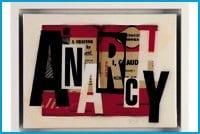I sometimes wonder if Vancouver-based artist and author Douglas Coupland has found a way to insert more hours into his days than most people, or if maybe he’s found a way to exist without sleeping. His creative output has tentacles everywhere. From film (Everything’s Gone Green), novels (Hey Nostradamus, Eleanor Rigby and the soon-to-be-released The Gum Thief) and television writing (Jpod the series), to furniture design, sculpture and photography, it’s all on his resumé. One can only assume his head is a very busy place.
His latest body of visual art is on display at the Toronto Monte Clark Gallery in the Distillery District. This show, The Penguins, is largely made up of rows of collages not much bigger than a flattened, open book. This body of work uses the covers of old Penguin paperbacks as their jumping-off point. If you are imagining dadaist collage you are pretty close. The overall format is pretty simple: book cover, bits of tape here and there, sticker letters from the hardware store to spell out a word, and thick, glossy varnish to finish it all off. The work looks crafty and is accessible. But, of course, there is more to it than that.
Being from the world of literature, it’s not surprising that Coupland’s work plays with text. Through the act of collaging these preexisting bits of ephemera, he lets us have a new look at something old. It is through Coupland’s keen sense of awareness that we step back and look at the world we live in, complete with its beauty and curiosity. The Penguins collages have a sense of play and wonder to them, of experimenting to see what will come when something is rearranged beyond its common use.
As the story goes, British publisher Allen Lane started Penguin books in 1935 with the goal of making quality paperback fiction available to a mass audience. The books were intended to be cheap and easy to get ahold of. They were recognizable at a glance with their uniform design scheme of orange and white stripes with black font. Coupland’s collages follow suit. Although they have a unified palette and are presented alphabetically by the words he’s overlaid, bits of chaos sneak in here and there. Walking into the gallery is like stepping into a reconfigured bookstore. There is familiarity in the work and in its order, but everything’s just a little bit scrambled.
By using only the book covers, Coupland emphasizes the visual design of the Penguin brand. The books are turned into aesthetic objects; their guts, their stories are nowhere to be found. Instead, a different set of stories is told. There are stories of history, of bringing a past cultural phenomenon into the present. There are the implied stories of the journeys the books themselves have taken, price tags intact, bends and wear marks still apparent.
Then there are the stories Coupland creates by adding text on top of the work. It’s a mixed bunch of references to be sure. While many of the collages stand on their own, with singular words across the surface, others are grouped together with phrases taking shape across several pieces. Phrases such as “love/will/ tear/us/apart,” a nod to Joy Division, and “no/future” from the Sex Pistols, reference the punk and new wave music scenes of the 1980s. Music fans will revel in playing guess the reference. The Penguins are a hybrid of a do-it-yourself cut-and-paste aesthetic and the oft-privileged world of visual art.
Also on display in the Monte Clark front gallery space is a Coupland wall installation piece titled Luxury Factory Number One. The work is made up of dozens of brightly coloured spools of thread resting on a pegboard. There is a hint at unravelling with the threads making their way to the floor. In the same way that The Penguins are a reimagining of a series of books, Luxury Factory could be a reimagining of British artist Damian Hirst’s work. However, in its simplicity and isolation Luxury Factory could be almost anything. Terrible or fantastic, the work will never speak its intentions.

 Why you can trust Xtra
Why you can trust Xtra


